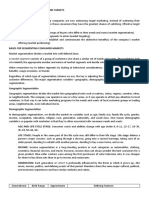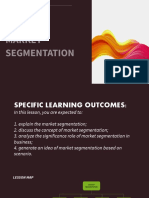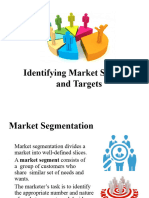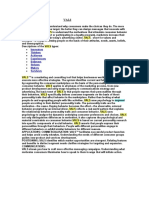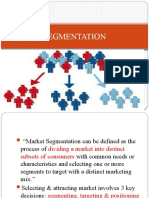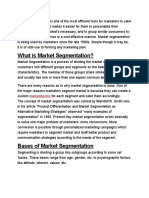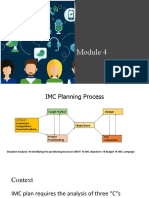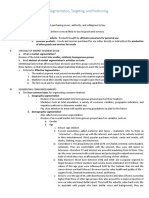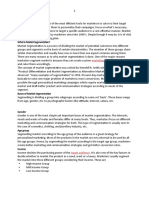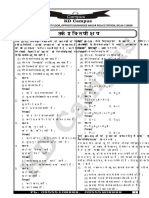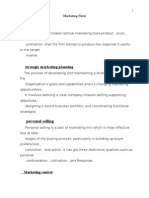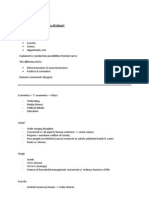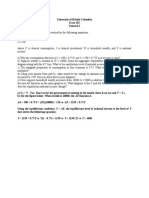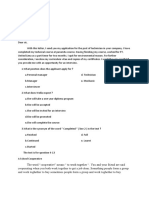Market Segmentation
Companies cannot connect with all customers in large, broad or diverse markets. But they can divide
such markets into groups of consumers or segments with distinct needs and wants. A company then
needs to identify which market segments it can serve effectively.
Market segmentation divides a market into well-defined slices. A market segment consists of a group
of customers who share a similar set of needs and wants. The marketer’s task is to identify the
appropriate number and nature of market segments and decide which one to target.
We use two broad groups of variables to segment consumer markets. Some researchers try to define
segments by looking at descriptive characteristics: geographic, demographic, and psychographic.
Then they examine whether these customer segments exhibit different needs or product responses.
Other researchers try to define segments by looking at behavioural considerations, such as
consumer responses to benefits, usage occasions or brands. The researcher then sees whether
different characteristics are associated with each consumer response segment.
Geographic Segmentation
Geographic Segmentation divides the market into geographical units such as nations, states, regions,
counties, cities or neighbourhoods. The company can operate in one or a few areas, or it can operate
in all but pay attention to local variations.
Demographic Segmentation
Age, Family Size, Gender, Income, Occupation, Education, Socio Economic Classification
Psychographic Segmentation
One of the most popular commercially available classification systems based on psychographic
measurements in Strategic Business Insight’s VALS framework. VALS signifies Values and Lifestyles. It
classifies US adults into eight primary groups based on responses to a questionnaire featuring 4
demographic and 35 attitudinal questions.
The main dimensions of the VALS segmentation framework are consumer motivation (the horizontal
dimension) and consumer resources (the vertical dimension). Consumers are inspired by one of
three primary motivations: Ideals, achievement and self-expression. Those motivated by ideals are
guided by knowledge and principles. Those motivated by achievement look for products and services
that demonstrate success to their peers. Consumers whose motivation is self-expression desire
social or physical activity, variety, and risk. Personality traits such as energy, self-confidence,
intellectualism, novelty seeking, innovativeness, impulsiveness, leadership and vanity in conjunction
with key demographics determine an individual’s resources. Different levels of resources enhance or
constrain a person’s expression of his or her primary motivation.
The four groups with higher resources are:
1. Innovators- Successful, sophisticated, active, “take charge” people with high self-esteem.
Purchases often reflect cultivated tastes for relatively upscale, niche-oriented products and
services.
2. Thinkers- Mature, satisfied, and reflective people motivated by ideals and who value order,
knowledge, and responsibility. They seek durability, functionality and value in product.
� 3. Achievers- Successful, goal-oriented people who focus on career and family. They favour
premium products that demonstrate success to their peers.
4. Experiences- Young, enthusiastic, impulsive people who seek variety and excitement. They
spend a comparatively high proportion of income on fashion, entertainment, and socializing.
The four groups with lower resources are:
1. Believers- Conservative, conventional and traditional people with concrete beliefs.
2. Strivers- Trendy and fun loving people who are resource constrained. They favour stylish
products that emulate the purchases of those with greater material wealth.
3. Makers- Practical, down to earth, self-sufficient people who like to work with their hands.
4. Survivors- Elderly, passive people concerned about change and loyal to their favourite
brands.
Behavioural Segmentation
In Behavioural segmentation, marketers divide buyers into groups on the basis of their knowledge
of, attitude toward, use of, or response to a product.
Needs and Benefits
Decision Roles- Initiator, Influence, Decider, Buyer and User.
User and Usage- Real user and usage related variables
Occasions
User Status- Nonusers, Ex Users, Potential users, first time users, and regular users.
Usage Rate
Buyer Readiness Stage
Loyalty Status
Hard Core Loyals
Split Loyals
Shifting Loyals
Switchers
Attitude
Multiple Bases







